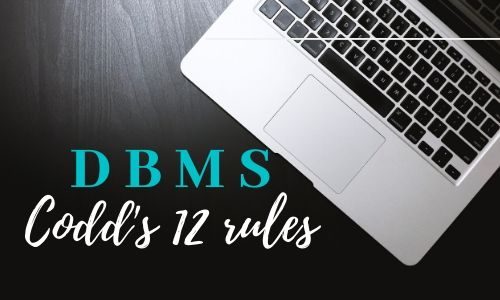Table of Contents
12 Codd Rules for RDBMS:-
Codd Rules for RDBMS were given by E.F Codd which should be satisfied by the DBMS to become an RDBMS. Dr. E.F codd describes the relational model in 1970. He has put 12 rules to describe the Relational Model.

12 Codd’s Rules for RDBMS:-
Dr. E.F codd was given 12 codd’s rules which are given below
Zero Rule:-
For a system to qualify as an RDBMS it must be able to manage its databases entirely through its Relational capabilities
Rule -1 | Information rule:-
All Information is to be represented in tables. • The rows and columns have to be strictly unordered. Metadata (data about data ) is also represented in the form of tables. It means All the data must be in a table format.
Rule -2 | Guaranteed Access:-
The data can be accessed by specifying the table name and the column name and the column that defined the primary key. The primary key ensures that each value is unique and accessible.
Rule -3 | Systematic Treatment Of Null Values:-
- NULLs may mean: Missing data, Not applicable, No value
- Should be handled consistently – Not Zero or Blank
- Primary keys — Not NULL
- Expressions on NULL should give NULL
- null !=0
- null != nothing
- null != null
- null is null
Rule -4 | Active Online Catalog Based On The Relational Model:-
Database dictionary (Catalog) to have a description of the Database. Catalog to be governed by the same rules as the rest of the database. The same query language is to be used in the catalog as on the application database
Rule -5 | Comprehensive Data Sub-Language Rule:-
One well-defined language to provide all manners of access to data for example SQL. If a file supporting a table can be accessed by any manner except a SQL Interface, then a violation
Rule -6 | View Updating Rule:–
All views that are theoretically updatable should be updatable. View (Virtual table), temporarily derived from base tables. Example: If a view is formed as a join of 3 tables, changes to the view should be reflected in base tables.Not updatable: View does not have a NOT-NULL attribute of the base table. Problems with computed fields in view e.g. Total Income = White income + Black income
Rule -7 | High-Level Insert, Update And Delete Rule:-
Data manipulation operations treat rows as a set. these set operations and relational operators are used to work on the table.
Rule -8 | Physical Data Independence Rule:-
The physical storage of data should not matter to the system. I say some file supporting table was renamed or moved from one disk to another, it should not affect the applications
Rule -9 | Logical Data Independence Rule:-
If there is a change in the logical structure (table structures) of the database the user view of the data should not change. implemented through views. Say, if a table is split into two tables, a new view should give results as the join of the two tables. Difficult rule to satisfy
Rule -10 | Integrity Independence Rule:-
The database should be able to enforce its own integrity rather than using other programs. Integrity rules filter to allow correct data, which should be stored in the Data Dictionary. Key and check constraints, triggers, etc should be stored in the Data Dictionary. This also makes RDBMS independent of front end
Rule -11 | Distribution Rule:-
A database should work properly regardless of its distribution across a network. This lays the foundation of Distributed databases. Similar to Rule8 only that applies to distribution on a local Disk
Rule -12 | Non-Subversion Rule:-
If low-level access is allowed to a system it should not be able to subvert or bypass integrity rules to change data. This may be achieved by some sort of locking or encryption. Some low-level access tools are provided by vendors that violate these rules for extra speed.
So these are the 12 Codd Rules which are used to identify whether DBMS is RDBMS or not.
Read the more interesting article: click here
Read the more interesting article on insurance companies in India: click here
If you have any queries on the database management system then comment your questions
Thank you
